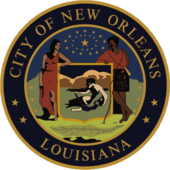Algiers, New Orleans
Algiers /ælˈdʒɪərz/ is a section of New Orleans, the only Orleans Parish community located on the West Bank of the Mississippi River. Algiers is known as the 15th Ward, one of the 17 Wards of New Orleans.[1] The neighborhood became the birthplace of Jazz as it was once home to many of the early African American Jazz artists in the early 1900s. This neighborhood is the second oldest in the city and is considered a historic piece of land to the History of New Orleans.[2][3][4][3][4]
Algiers 15th Ward | |
|---|---|
New Orleans Neighborhood | |
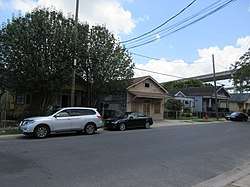 | |
| Coordinates: 29°55′30″N 90°00′50″W | |
| Country | United States |
| State | Louisiana |
| City | New Orleans |
| Police District | District 4, Algiers |
| Area | |
| • Total | 0.62 sq mi (1.6 km2) |
| • Land | 0.62 sq mi (1.6 km2) |
| • Water | 0.00 sq mi (0.0 km2) |
| Population (2010) | |
| • Total | 25,995 |
| • Density | 42,000/sq mi (16,000/km2) |
| Demonyms | Algierene, or Algerine |
| Time zone | UTC-6 (CST) |
| • Summer (DST) | UTC-5 (CDT) |
| Area code(s) | 504 |
History
Jean Baptiste le Moyne, Sieur de Bienville, was granted a large tract of land on the west bank of the river opposite New Orleans in 1719. This date is sometimes given as the year of the town's founding, making it one of the oldest neighborhoods in what is now New Orleans, but development as a town as opposed to a private plantation did not actually occur until about 1800. The name is believed to have come from the proximity to the city as compared to France and Algeria. Another theory is that a soldier returning from fighting in Algeria decided it looked just like that country when viewed from a ship.[5]
_001.jpg)
A powder magazine was built here for safety reasons and because it stood on higher ground. A slaughterhouse was also established and Algiers went by the name of Slaughterhouse Point for some time.
With the importation of African slaves in the 18th century, this area was used as a holding area until those who survived the sea voyage recovered enough to be dispatched across the river to be sold in the French quarter. Algiers was also a holding area for the Cajuns who survived the Great Upheaval, when the British expelled them from Nova Scotia.[5] The oldest part of Algiers is Algiers Point, across the river from the French Quarter.
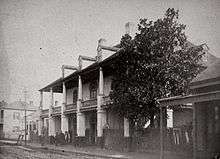
The Duverjes built their plantation home in Algiers in about 1812. They would become the first family of Algiers and their home would later become the Algiers Courthouse. Algiers Point has been connected with the foot of Canal Street in downtown New Orleans by the Canal Street Ferry since 1827. It is one the oldest continuously operated ferry services in North America. Part of the Battle of New Orleans, in January 1815, was fought on the West Bank in what is now Algiers. Original earthworks remain, and the site is marked with a historical marker on Patterson Drive in the Aurora neighborhood.
Much land in Algiers and elsewhere in south Louisiana was owned by John McDonogh, who was one of the world's largest private land owners until his death in 1850. His estate was willed to public schools in Baltimore and New Orleans.[6][7] [8] McDonogh's home was located on the river south of Algiers point, but the land has since been washed away.[9] McDonogh's grave is in the McDonogh Cemetery in Gretna. Algiers was incorporated as a city in 1840. Shipbuilding was an important industry here.
In the 1850s, Algiers became a major railroad center and eastern terminus of the New Orleans, Opelousas and Great Western Railroad. Ferries were utilized for nearly a century to carry passengers, freight, and rail cars across the Mississippi River between the West Bank (including Algiers) and the East Bank (Central Business District of New Orleans).[10] Later, the railroad yard at Algiers would become the eastern repair shop for the Southern Pacific Railroad. The SPRR shop employed 4000 and had the capability to build mechanical parts for steamships.[9]
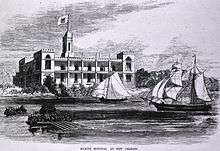
In April 1862, during the American Civil War, flames arose from the shipyards in Algiers as Confederate officials destroyed property that might benefit the invading Union troops. Historian John D. Winters, in his The Civil War in Louisiana (1963), notes that the New Orleans populace was "'amazed and could scarcely realize the awful fact, and ran hither and thither in speechless astonishment.' . . . Shocked out of their dumb disbelief, many people joined in the destruction. Cotton was rolled from the warehouses, ships loaded with produce were boarded, and fire was set to the lot. Crowds of the city poor broke open warehouses and carried away baskets, bags, and carts spilling over with rice, bacon, sugar, molasses, corn, and other foods. What they could not carry away they attempted to destroy by dumping in the river, burning, or throwing into the open gutters. A mob broke into the powder and gun factories in the Marine Hospital and carried away rifles and ammunition. The city was a frenzy of disorganized activity."[11]
In 1870, Algiers was annexed to the city as the 15th Ward, an arrangement which has remained although there have been repeated discussions of secession. Until the latter 1930s, rail yards housed large amounts of freight and rolling stock, which was brought back and forth across the Mississippi River by barge. Then, the Huey P. Long Bridge, which included a railway bridge, was built upriver at Bridge City, Louisiana. The largest railroad presence had been the Southern Pacific yard.[9] That location is still known to Algerines as "the SP yard." For decades it was largely a vacant strip. Portions of the tract were redeveloped for housing in the early 21st century. In the yard's active days, a steam-powered Southern Pacific train ferry brought railroad cars from there across the Mississippi River. The Algiers rail yards were known for their ability to repair or create replacements for any part needed for any type of locomotive and mechanical parts for ships.[9]

A fire destroyed most of the buildings in Algiers in 1895.[9] Most of the gingerbread-fronted houses seen in the neighborhood today date from the rebuilding that began almost immediately after that fire; although a small number of older buildings still survived. In the early decades of the twentieth century, Algiers was the home of Martin Behrman, the longest-serving mayor of New Orleans. In 1901, the U.S. Navy established a naval station in Algiers. From 1966 until 2009, the site was one of the two campuses of the Naval Support Activity New Orleans base. Now the shuttered facility's West Bank campus is being redeveloped as a federal city. For centuries, intensive settlement in Algiers extended little beyond Algiers Point. The completion of the Greater New Orleans bridge across the Mississippi River in 1958 (now the Crescent City Connection) and the construction of Victory Drive (now General DeGaulle) and General Meyer Avenue made significant new development possible, and Algiers grew rapidly for the next 25 years.
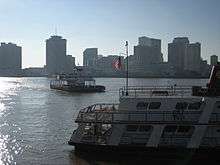
An early history of Algiers is The Story of Algiers by William H. Seymour, published in 1896. The book was republished in 1971 and has been referenced in New Orleans and Louisiana histories.[9] An index of the book is online at the New Orleans Public Library website.[12]
Segregation
In the late 1880s, Algiers was segregated due to the Jim Crow Laws of the South. During Jim Crow, African Americans were not allowed in Algiers Point. Some of the early black neighborhoods in Algiers included Tunisbourg McCLendonville, LeBeoufville, Hendeeville, Oakdale and the Whitney District.[13] After John McDonogh died in 1850 he established "Freetown" for freed slaves and other people of color. Freetown was renamed McDonoghville and became mostly black [14] Many Jazz artists such as Kid Thomas Valentine, Red Allen and Bill Mathews all grew up in the area in the early 1900s and were all a part of Algiers Tuxedo Brass Band.[15] In 1938 L.B. Landry High school opened as the first all black high school in Algiers. The school was named after Dr. Lord Beaconsfield Landry, who lived in the area and died in 1934. It was the first school to serve African-Americans in Algiers and was located on Whitney Avenue in the Whitney District which was once a part of King's Plantation.[16][17] Around the early 1940s several schools and neighborhoods were built for African Americans, including Peter S. Lawton School and Oakdale. Oakdale once stood south of Algiers Point and stretched from Whitney Avenue to the Mississippi River. It was one of the larger African-American communities in Algiers and was partly destroyed in the late 1950s to make room for the Greater New Orleans Bridge. Newton Street in McDonoghville, became the heart of Algiers's black community as it was once occupied with bars, Juke joints, grocery stores and small restaurants. The most famous, Greystone Voter's League, became the place for Rhythm & Blues shows and great singers such as Ray Charles, Son House, and B. B. King, who all played there. The busy street would slowly decline by 1965, at which that time Oakdale was completely destroyed and built over for the Fischer housing project. Algiers was completely desegregated by 1968 due to the Civil Rights Act of 1964.[18]
Demographics
The Algiers neighborhood is predominantly African American, with 89.4% of residents identifying as such in the 2000 Census.[19] Algiers' total population pre-Katrina, according to the census, was 28,385 of whom 45.9 were male and 54.1 female. The average age is 29.6, while the population for children under 5 was 2,515. Aged 18 and over was 19,204, while 65 and over were a total of 2,839. Whites make up 21.8 per cent of the population in Algiers Point, while African-Americans make up 73.6. Native Americans and Alaskan Natives are 0.2 per cent of the population. Hawaiians barely registered, and Latino/as make up 4.3 percent. The average household size is 2.68; the average family size is 3.41. The total number of housing units in Algiers was 12,351; of those, 83.9 per cent were occupied, and 16.1 vacant. 40.6 of those units are owned by home owners, while 59.4 are rented. Socially speaking, 72.3% are high school graduates, and 14.3% hold at least a bachelor's degree. The married population is 41.2 percent male, and 33.2 are female. Families that are below the poverty level are at 30.3%; individuals below the poverty level are 35.3%.[20]
Poverty
Algiers suffers from a high poverty rate of between 14.3% and 40% in most census blocks, according to the most recent federal data collected between 2007 and 2011 and assessed by The Data Center, an organization that researches community demographics in Southeast Louisiana.[21] The 70114 section of Algiers is among the lowest income neighborhoods in America, below 91.3% of U.S. neighborhoods. With 54.4% of the children living below the federal poverty line, it has a higher rate of childhood poverty than 92.5% of U.S. neighborhoods. The 70131 zip code in Algiers contains affluent subdivisions such as English Turn, Woodland Heights, Packenham Oaks, Lakewood, and Park Timbers.
Many neighborhoods in Algiers are occupied by low-income African American families, with many homes over-filled with relatives living in them as well. In the late 1960s, some neighborhoods in Algiers began to decline with boarded up houses and overgrown grass. Trash lined the streets, and some of the French-textured shotgun houses didn't have air conditioning units. This led to families sitting outside on their porches with fans and kids busting the fire hydrants open to play in the water. In a 1971 article, certain areas in Algiers were described as "dirty" and "nasty." During that time, residents in the poor neighborhoods didn't have as much money as whites to keep their houses in good condition.[22]
Crime
Unlike Algiers Point, the crime rate for Old Algiers has always been extremely high with gun violence being the main issue. Statistically, parts of Algiers like Berhman are notorious for high-profile crimes, violence and drug activity. Before Hurricane Katrina, most of the crimes committed occurred in the deprived and run-down neighborhoods as well as in low income housing developments such as the notorious Fischer Projects which was one of the worst housing projects in the country. Other housing areas like the troubled DeGaulle Manor complex, and Christopher Homes were also known for violence.[23][24] The crime rate increased by 15% with a 12% increase in violent crimes and homicides in the late 1980s. According to 1993 statistics, Algiers has seen a 20.8 percent decrease in crime in 1992 compared with 1991.[25] At the end of 2012 Algiers murders skyrocketed to 23 killings, a dramatic increase from the previous year. That same year crime began to spread into the smaller middle income communities of Tall Timbers, Old Aurora and Garden Oaks.[26][27] Murders decreased in 2014, but crime reports showed an increase in robberies and violent crime.[28] But in 2015, Algiers murder rate rose to 24 homicides, the highest since 2012. Majority of the homicide victims were African-American men between the ages of 17 and 40. The killings were either drug-related or domestic incidents. By the end of 2016, homicides were down to 15.[29][30] Even so, violent crimes increased, with burglaries up 11% and shootings (fatal or non fatal) up 4%. Auto theft jumped almost 30%. The biggest increase was rape and sexual battery, increasing by nearly 50%.[31] In 2017 the 4th District teamed with the NOPD's street-gang unit to quell gun battles spurred by conflicts between neighborhood groups, NOPD officer Ruffin said. The groups were formed of loose associations among people, not stable enough to be considered traditional gangs, and had "some very petty, petty beefs that led to very violent encounters," he said. To reduce Crime Law enforcement installed 13 crime surveillance cameras, including 10 fixed cameras and three mobile cameras, along with five license-plate readers, including three fixed readers and two mobile readers.[32][33]
Death of Henry Glover
Henry Glover was an African American resident of New Orleans, Louisiana whose charred body was found in a destroyed Chevrolet Malibu on September 2, 2005, parked on a Mississippi River levee. Five current and former officers of the New Orleans Police Department (NOPD) were charged with Glover's death. First to be charged was former NOPD police officer David Warren, a rookie at the time, who was convicted and sentenced to 25 years and 9 months in prison for shooting and killing Glover. Former NOPD police officer Greg McRae was convicted of obstructing justice and other charges in the burning of Glover's body and was sentenced to 17 years and 3 months in prison.
On Dec. 17, 2012, the Fifth Circuit Court of Appeals vacated the two felony convictions of Warren and two of the convictions related to McRae, ordering new trials on those charges. The three-judge panel found, among other concerns, that the trials of the two men should have been conducted separately.[4] On December 11, 2013, a jury acquitted Warren on both counts against him.[5]
Today
A number of New Orleans carnival krewes have their "dens" (warehouses where their floats are constructed and stored) in Algiers. Algiers Point was placed on the National Register of Historic Places in 1978 and designated a local historic district in 1994.[34] Algiers is home to many churches. There are numerous Catholic and Baptist congregations. The oldest Lutheran congregation, Trinity Evangelical Lutheran Church, was founded in 1875.[35] Trinity's steeple was blown off by Hurricane Katrina in 2005. A Catholic congregation, as well as Methodist and Episcopalian congregations, are all on the Historic Register of New Orleans, and some Algiers churches are listed on the National Historic Landmark lists. There are two branches of the New Orleans Public Library located in Algiers.[36] The Cita Dennis Hubbell Branch was built in 1907 as the Pelican Avenue Branch, one of three Carnegie libraries in New Orleans. Following years of neglect and hurricane damage, the library's roof was found to be in imminent danger of collapse and the location was closed on May 2008.[37] The Hubbell Branch was temporarily located at the Algiers Courthouse Carriage House a few blocks away, until it re-opened in the summer of 2013 in the original Pelican Avenue location. The Algiers Regional Branch, two miles away, was a larger library built in 1966. This library was damaged extensively by Katrina. The building was demolished and a new library constructed, which opened in early 2013.[38]
The area upriver from the Point was historically known as McDonoghville (which extended into part of what is now Gretna). Downriver from the Point is the West Bank portion of Naval Support Activity New Orleans, the largest military installation in the Greater New Orleans area. Further downriver from this is the neighborhood of Aurora, lower Algiers (Cutoff, River Park) and further still, the English Turn area, which was not substantially developed until the late 20th century. On September 26, 2005, Algiers became the first major section of New Orleans to be reopened to residents after Hurricane Katrina. Although a number of buildings suffered wind damage from the storm, Algiers escaped the flooding which affected most of the East Bank.
Culture
People from Algiers have traditionally been known as "Algerines". Noted Algerines have included jazz musicians Jimmy Palao, Red Allen, Bill Mathews, Kid Thomas Valentine, Emmett Hardy, and R&B singer Clarence "Frogman" Henry. Jazz musicians of the 1920s referred to Algiers as "over da river" or the "Brooklyn of the South", the latter for its proximity to New Orleans as compared to New York and Brooklyn, both separated by a river.[39][40][41]
Algiers has many nicknames including "A.L.G", "The Darkside", and "1.5" referring to the 15th Ward in which the neighborhood is situated. It was also referenced by rapper Gregory D in his 1988 single "Buck Jump Time".[42][43] Rap artists who grew up in Algiers include G-Slimm, Joe Blakk and Tre 8. Super Sunday has been held in the community since the 1970s. The gathering is an annual celebration of Mardi Gras Indian tribes parading down Whitney and Newton Streets. It also includes picnics and music concerts which are held in the nearby Fox Park. Thousands of people attend the celebration which starts on Sunday morning all the way to midnight. For many years shootings and physical conflicts have occurred frequently during the event. NOPD threatened to shut down Whitney Avenue which is where the 15th Ward Indians parade, but residents of Algiers still attend the celebration yearly as it is a part of the culture.[44] On May 24, 2009 a man was shot in the head as he was attending the event.[45]
The funeral ritual known as a "second line" or "Repass" is traditional in Algiers, in which a brass band parades through the area after a funeral service. The "main line" or "first line" is the main section of the parade, or the members of the actual club with the parading permit as well as the brass band. Those who follow the band just to enjoy the music are called the "second line". Although second line parades celebrate the passing of a loved one, it can also turn into a block party. The origins of the second line date back to the late 1800s.[46][47] Louis Armstrong's last New Orleans gig before he left the city for Chicago was in Algiers at a Teche Street funeral home.[48]
Krewe of NOMTOC
The Krewe of NOMTOC (New Orleans Most Talked Of Club) began parading on the Westbank (Orleans Parish) in 1970. Their inaugural parade had six floats, six bands, six marching units, one horse group and a motorcycle squadron. Today, this all-black krewe is composed of 400 male and female riders, 26 floats, ten bands and a number of marching and riding groups. Throws include ceramic medallion beads, jug banks and their signature Jug Man dolls. Their most popular throws for the 2013 parade included: Medallion Tri-Color Bead, Stuffed Baseball, Lighted Medallion Bead, Velour Spear with Krewe Crest, Top Hat Bead with Gold Pearls. The Krewe suggests that the best spots for family viewing are Holiday Dr. and Gen. Meyer Ave., in front of Behrman Stadium, along Mardi Gras Blvd., or at the intersection of Nunez St. and Mardi Gras Blvd. The Krewe's sponsor, The Jugs Social Club, has a rich heritage of civic activism, regularly donating funds to local schools, youth groups, and social programs. Each year a group of academic honor students is selected as guest riders in the parade.[49]
Neighborhoods
Algiers contains many neighborhoods such as
- Algiers Point
- McDonogh
- Old Aurora
- New Aurora
- Lower Algiers (Cutoff, River Park)
- Whitney
- Behrman
- Fischer Housing Development
- Tall Timbers/Brechtel
- McClendonville
Education
Primary and secondary schools
Algiers is zoned to schools in the Orleans Parish School Board (OPSB), also known as New Orleans Public Schools (NOPS). The district has its headquarters in the Westbank area of Algiers.[50]
For the 2006-2007 school year, parents have a choice between the following NOPS operated schools:
- Benjamin Franklin Elementary School (K-8)
- Bethune Elementary School (K-8)
- McDonogh 35 High School
As of 2016 some other agencies have supervision over public charter schools in Algiers. All public schools in New Orleans will return to supervision by OPSB by July 1, 2018.[51]
Students may attend schools operated by the Algiers Charter Schools Association ()
The schools include:
- Martin Behrman Elementary School (K-8)- Algiers Point
- Dwight D. Eisenhower Elementary School (K-8)- Tall Timbers/Brechtel
- William J. Fischer Elementary School (K-8)- Fischer Development
- McDonogh #32 Elementary School (K-8)- McDonogh
- L.B Landry - O.P. Walker College and Career Preparatory High School - Old Algiers
The InspireNola Charter Schools operate
- Edna Karr High School- Old Aurora
- Alice M. Harte Elementary School (K-8)- Old Aurora
Crescent City Schools include
- Harriet Tubman Charter Elementary School
- Paul B Habans Elementary School
One campus of the International School of Louisiana (ISL) is in Algiers.[52]
Colleges and universities
Colleges and universities:
- Our Lady of Holy Cross College
- Delgado Community College
Public libraries
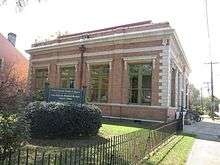
New Orleans Public Library (NOPL) operates the Algiers Regional Library. It was first established in 1966.[53] Hurricane Katrina damaged the original building in 2005. Prior to the construction of the new library, Algiers residents used the temporary Cita Dennis Hubbell Branch, located in a museum, and a trailer adjacent to the damaged Algiers Regional Branch. The damaged building was demolished in 2010,[54] and a new 28,000-square-foot (2,600 m2), $9.25 million Algiers Regional Library was constructed in its place. The architectural firm was Gould Evans Associates of Kansas City, Missouri, and the construction company was Gibbs Construction.[55] Gould Evans worked with New Orleans firm Lee Ledbetter & Associates to design this library and four others.[56]
The Federal Emergency Management Agency (FEMA) was to pay for the costs of demolition of the previous library and construction of the new library since the previous facility had been, according to FEMA's estimation, over 50% damaged by Katrina. The features and amenities present in the new facility that were not in the previous facility were financed by other sources, including New Orleans municipal bond sales and funds from the Louisiana Recovery Authority. The "design-build" process, one specially allowed only in parishes affected by Hurricane Katrina under Louisiana law, was used to rebuild this library and four others.[57]
Construction on the new Algiers Regional Library was supposed to begin in the summer of 2010 but construction delays occurred.[58] By March 2012 construction was about 55% done. The opening was scheduled for the summer of 2012.[55]
NOPL also operates the Cita Dennis Hubbell Library (formerly Algiers Point Branch) in Algiers Point.[59]
Notable people
- Henry "Red" Allen, jazz trumpeter and singer
- Jeff Arnold, politician
- Joe Blakk, rapper
- Gary Carter, Jr., politician
- Tre-8, rapper, producer
- Patricia Clarkson, actress
- J. Lawton Collins, World War II general
- Olaf Fink, educator and state senator from 1956 to 1972
- G-Slimm, rapper
- Alvin Haymond, retired NFL player
- Rich Jackson, former NFL defensive end
- Anthony Johnson, NFL defensive tackle for the New England Patriots
- Kilo G, rapper
- George Lewis, jazz clarinetist
- Kendrick Lewis, NFL free safety for the Baltimore Ravens
- Lance Louis, NFL Indianapolis Colts Offensive Guard
- Memphis Minnie, blues singer and guitarist
- Jimmy Palao, jazz musician
- James Ray, Denver Nuggets power forward
- Cyril Richardson, NFL guard for the Buffalo Bills
- Virgil Robinson former NFL New Orleans Saints running back
- Lou Sino, jazz trombonist and singer
- Herb Tyler, LSU Quarterback
- Kid Thomas Valentine, Jazz Trumpeter and pioneer of the Preservation Hall Jazz band
- Mike Wallace, NFL wide receiver for the Baltimore Ravens
See also
References
- "Archived copy". Archived from the original on February 16, 2016. Retrieved February 8, 2016.CS1 maint: archived copy as title (link)
- Campanella, Richard (August 8, 2017). "How Algiers grudgingly became part of New Orleans". Nola.com. Retrieved June 24, 2019.
- "Interview of musician Tom Albert" (PDF). Music Rising at Tulane University. September 25, 1959. Retrieved July 30, 2018.
- "Hogan Jazz Archive Photography Collection at Tulane University" (PDF). Hogan Jazz Archive at Tulane University. 1927. Retrieved July 30, 2018.
- "Algiers Historical Society". July 12, 2007. Archived from the original on July 12, 2007. Retrieved June 24, 2019.
- McDonogh, John (1851). The last will and testament of John McDonogh, late of MacDonoghville, state of Louisiana. New Orleans: Printed at the job office of The Daily Delta. LCCN 2002553168.
- Allan, William (1886). Life and Work of John McDonogh. Baltimore: I. Friedenwald. 152545752.
- Ciravolo, G. Leighton (2002). The legacy of John McDonogh. Lafayette LA: Center for Louisiana Studies, University of Louisiana at Lafayette. ISBN 1-887366-48-2.
- Seymour, William H. (1971). The story of Algiers, 1718-1896. Gretna LA: Pelican Publishing Company. LCCN 71162346.
- Dixon, Bill (2009). Last Days of Last Island: The Hurricane of 1856, Louisiana’s First Great Storm. Lafayette, LA: University of Louisiana at Lafayette Press. ISBN 1-887366-88-1.
- John D. Winters, The Civil War in Louisiana, Baton Rouge: Louisiana State University Press, 1963, ISBN 0-8071-0834-0, p. 96
- "What's New in NUTRIAS". New Orleans Public Library. Archived from the original on May 13, 2005. Retrieved April 28, 2006.
- "History of Algiers Point, New Orleans, Louisiana". Algiers Historical Society.
- "McDonogh Neighborhood Snapshot". Web.archive.org. June 5, 2013. Archived from the original on June 5, 2013.
- "Brass Band Jazz, Part Three". Offbeat.com.
- "L.B. Landry High School's namesake is remembered". Nola.com.
- "<GNOCDC> Whitney Neighborhood Snapshot". Datacenterresearch.org.
- "History". Oldalgiersmainstreet.org.
- "Algiers New Orleans, LA 70114, Neighborhood Profile". Neighborhoodscout.com.
- "Algiers, Louisiana: Demographics". Algierslouisiana.blogspot.com. March 16, 2009.
- "Impoverished district seeks to secede from New Orleans". America.aljazeera.com.
- Gush, Dan (November 13, 1972) [September 20, 1971]. "Poverty in The Ghetto". The Insider. New Orleans. 16: 45. Archived from the original on May 3, 2019. Retrieved May 14, 2019.
- Gettleman, Jeffrey (July 11, 2003). "New Orleans Struggles With a Homicide Rate That Belies Its Size". Nytimes.com.
- Hayward, Jef. "NOPD STRUGGLES WITH THE WAR ON DRUGS IN ALGIERS NEIGHBORHOOD". Neworleansnews.org. Missing or empty
|url=(help) - "New Orleans, LA Local News, Breaking News, Sports & Weather - NOLA.com". Nl.newsbank.com. Retrieved June 24, 2019.
- "Rash of killings plagues Algiers". Nola.com.
- LaRose, Greg (June 8, 2012). "NOLA version of 'Mayberry' copes with sporadic crime". Neworleanscitybusiness.com.
- "Archived copy". Archived from the original on November 19, 2015. Retrieved November 7, 2015.CS1 maint: archived copy as title (link)
- "Algiers 2015 Homicides map". Google My Maps.
- "Algiers 2016 Homicides map". Google My Maps.
- "Recent crimes have residents in Algiers on edge". Wwltv.com.
- "Algiers residents express fears, hear crime-fighting plans at community meeting". Nola.com.
- "New crime cameras flashing across New Orleans". Wwltv.com. Retrieved June 24, 2019.
- "National Register of Historical Places - LOUISIANA (LA), Orleans County". Nationalregisterofhistoricplaces.com.
- "Financial Planning & Guidance for Christians | Thrivent Financial". August 8, 2016. Archived from the original on August 8, 2016. Retrieved March 26, 2018.
- Branches and Bookmobiles Archived 2010-03-23 at the Wayback Machine. New Orleans Public Library. Retrieved on March 31, 2010.
- "Archived copy". Archived from the original on July 14, 2006. Retrieved March 5, 2006.CS1 maint: archived copy as title (link)
- "Archived copy". Archived from the original on June 16, 2006. Retrieved November 9, 2005.CS1 maint: archived copy as title (link)
- "History of Jazz in Algiers Louisiana". Algiers Historical Society.
- "The Brooklyn of the South" (DOC). View.officeapps.live.com. Retrieved June 24, 2019.
- "The Best of the West". Bestofneworlenas.com. Retrieved March 30, 2018.
- "The Fischer from that one point five". Genius.com.
- "Where They At: New Orleans Hip-Hop and Bounce in Words and Pictures. Aubrey Edwards and Alison Fensterstock. New Orleans 2010". Wheretheyatnola.com.
- "Super Sunday". Neworleansonline.com.
- "Man shot in Algiers near Super Sunday parades dies". Nola.com.
- "Second Line Sunday in Treme, Algiers - NOLA DEFENDER". Noladefender.com.
- "The New Orleans Second Line Parade is a Historical Tradition". Frenchquarter.com.
- "Fragments of Louis Armstrong when he was on the cusp of greatness". Nola.com.
- "Krewe of NOMTOC - Mardi Gras New Orleans". Mardigrasneworleans.com.
- "Central Office Staff Archived 2009-06-09 at the Wayback Machine." New Orleans Public Schools. Retrieved on December 15, 2009.
- "NOLA Schools Unification Archived December 15, 2016, at the Wayback Machine." Orleans Parish School Board. Retrieved on December 8, 2016.
- Tan, Sarah. "The International School of Louisiana opens in Harahan." Times Picayune. November 23, 2012. Retrieved on May 18, 2014.
- Valence, Kari Eve (September 19, 2016). "Algiers Library celebrates 50 years of service to community". The Times-Picayune. Retrieved December 10, 2016.
- Dequine, Kari (June 7, 2010). "Demolition makes way for new Algiers Regional Library". The Times-Picayune. Retrieved December 10, 2016.
- Donze, Frank (March 12, 2012). "New Orleans libraries turn over a new leaf with state-of-the-art buildings". The Times-Picayune. Retrieved December 11, 2016. - See inset image showing the pictures of the libraries that lists the costs and square footage
- Bruno, R. Stephanie. "Renovations to New Orleans area libraries bring them into 21st century." The Times-Picayune. June 24, 2011. Retrieved on March 31, 2013.
- Krupa, Michelle (August 12, 2009). "Public library rebuilding project set to begin". The Times-Picayune. Retrieved December 11, 2016.
- Powell, Allen II (May 9, 2011). "Algiers library construction delay upsets, puzzles residents". The Times-Picayune. Retrieved December 11, 2016.
- "Cita Dennis Hubbell Library." New Orleans Public Library. Retrieved on December 11, 2016.
External links
| Wikimedia Commons has media related to Algiers, New Orleans. |
| Wikivoyage has a travel guide for Algiers, New Orleans. |
